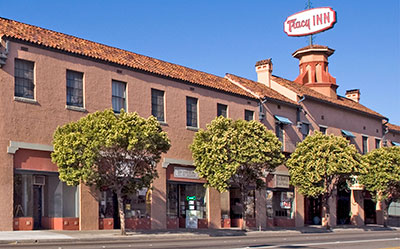National Register of Historic Places in San Joaquin County
Tracy Inn
24 West 11th Street
Tracy
Built 1927
Until the 1920s, Tracy had been a railroad town. Automobile traffic stimulated the design of the first hotel away from the tracks, the Tracy Inn.
Sponsored and promoted by the local residents in 1925, the Tracy Inn was planned as the community focal point. Meetings, parties and banquets have graced the Inn over the years and continue to do. Businessmen, too, have travelled the corridor between the San Francisco Bay area and the San Joaquin Valley, stopping at the Tracy Inn.
In their design for the Tracy Inn, the Oakland architectural firm, Slocombe & Tuttle, combined Spanish Colonial Revival and Moderne elements . The building evokes the end of a significant period of California architecture inspired by Spanish buildings - the Mission Revival Style (1890-1920) followed by the Spanish Colonial Revival Style (1915-1940).
The widely popular Mission Revival style was commonly adopted in California for schools, hotels, railroad depots, houses and public buildings. By 1915, many critics of the "Mission rash" advocated a more correct, scholastic version of Spanish architecture. This new style was called Spanish Colonial Revival.
Details of the Mission Revival and the Spanish Colonial Revival were similar. In many California communities, a continuous "Spanish flavor" was generated by the two architectural styles for half a century. The Tracy Inn marks the close of the Spanish style which had been popular in Tracy from 1900-1925.
The Moderne features foreshadow architectural design popular between 1930-1945. The sleek, planar Moderne was especially appropriate for a highway hotel and meeting place. Until the completion of the Highway 205 Bypass in 1970, 11th Street was Tracy's city link of the Lincoln Highway.
Adapted from the NRHP nomination.

The Lincoln Highway
The Lincoln Highway, conceived in 1912 and formally dedicated October 31, 1913, was the first road to cross the United States. It ran from Times Square in New York City to Lincoln Park in San Francisco passing through thirteen states: New York, New Jersey, Pennsylvania, Ohio, Indiana, Illinois, Iowa, Nebraska, Colorado, Wyoming, Utah, Nevada, and California.
In 1925, the US Bureau of Public Roads eliminated named trails and highways, and Lincoln Highway became drab series of numbers: US 1, US 30, US 40, US 50.
One of the last actions of the Lincoln Highway Association before it closed, was to order the casting of 3,000 concrete markers, to dedicate the highway to the memory of Abraham Lincoln. A rectangular head on top of a hexagonal shaped post, the markers featured the Lincoln Highway logo, a bronze medallion and arrows to indicate the route of the memorial highway. The US Bureau of Public Roads allowed the placement of these markers along the length of the old highway.
According to the 1916 edition of the Lincoln Highway Association Official Road Guide, a trip from the Atlantic to the Pacific was "something of a sporting proposition" and might take twenty to thirty days. Motorists were advised to top off their gasoline at every opportunity and to wade through water before driving through to verify the depth. Recommended equipment included chains, a shovel, an axe, jacks, tire casings, inner tubes and sundry tools. Firearms were not necessary, but west of Omaha full camping equipment was recommended.
Source: Lincoln Highway Association and others.

